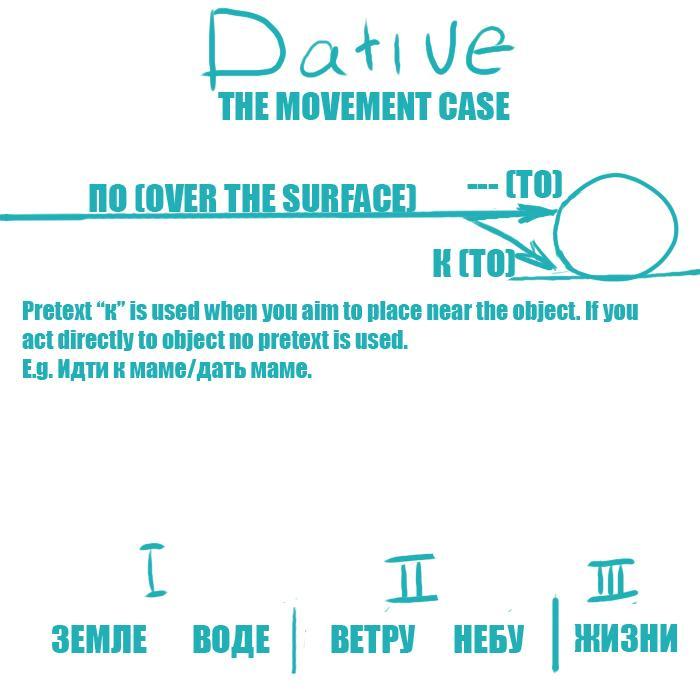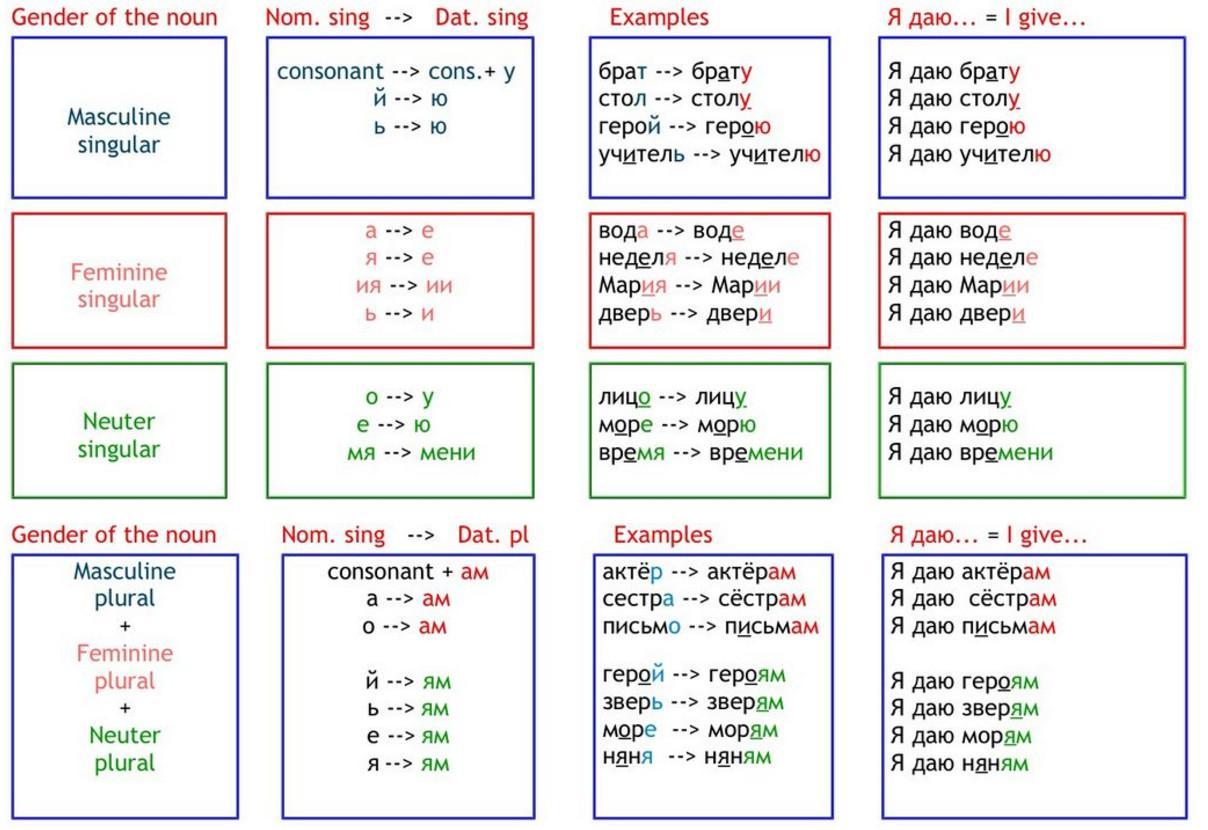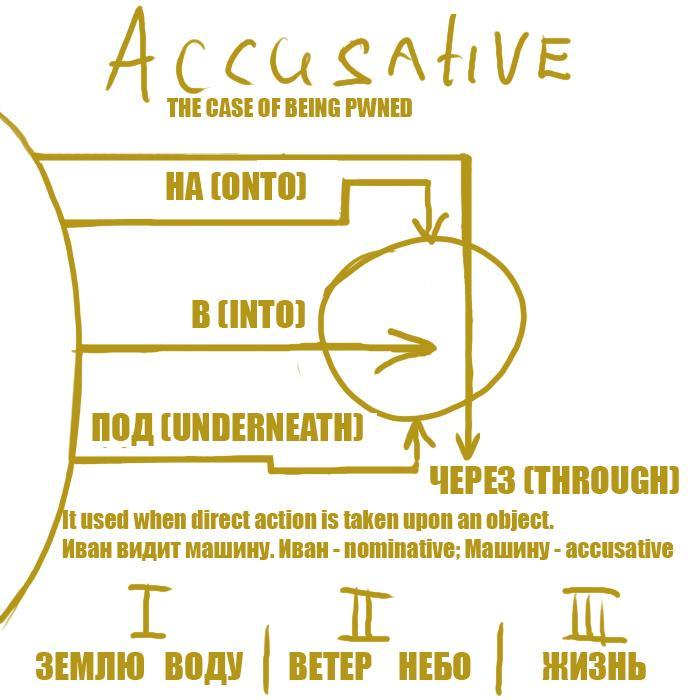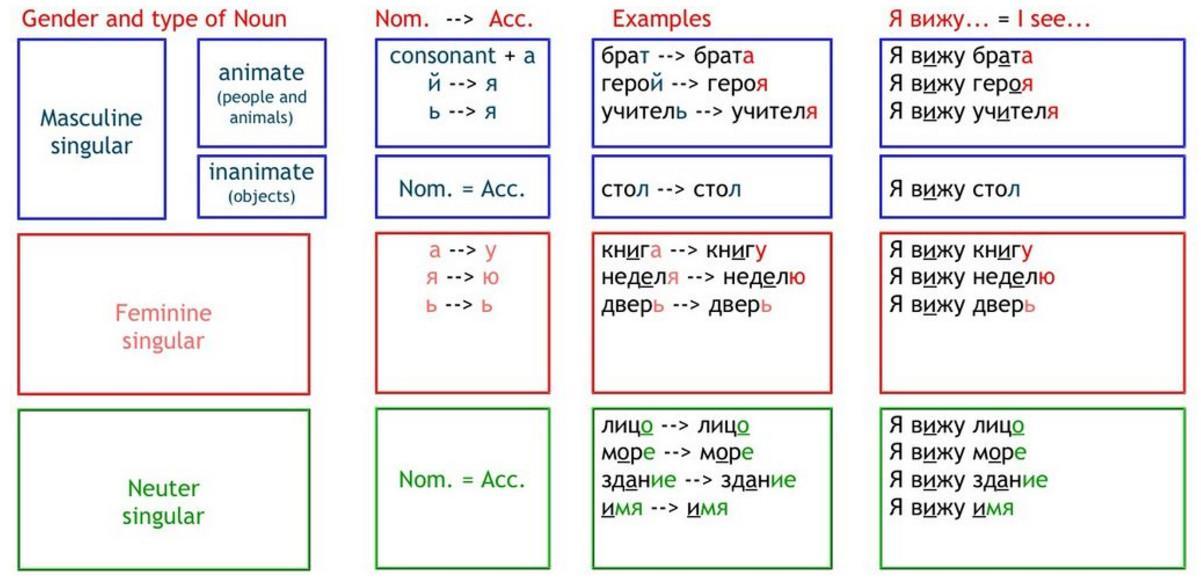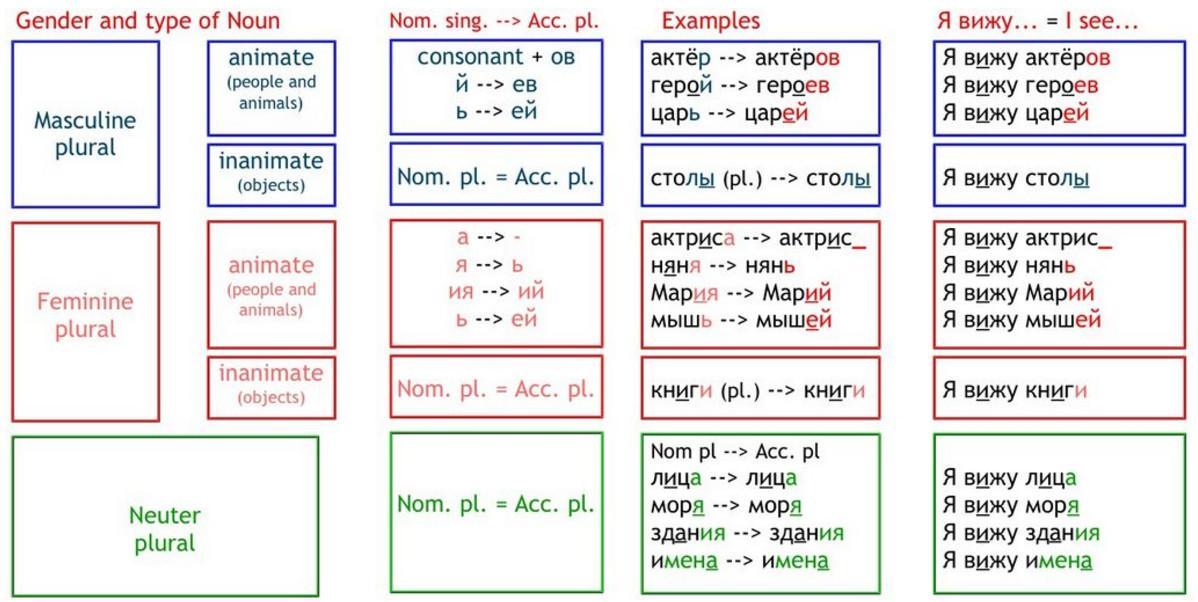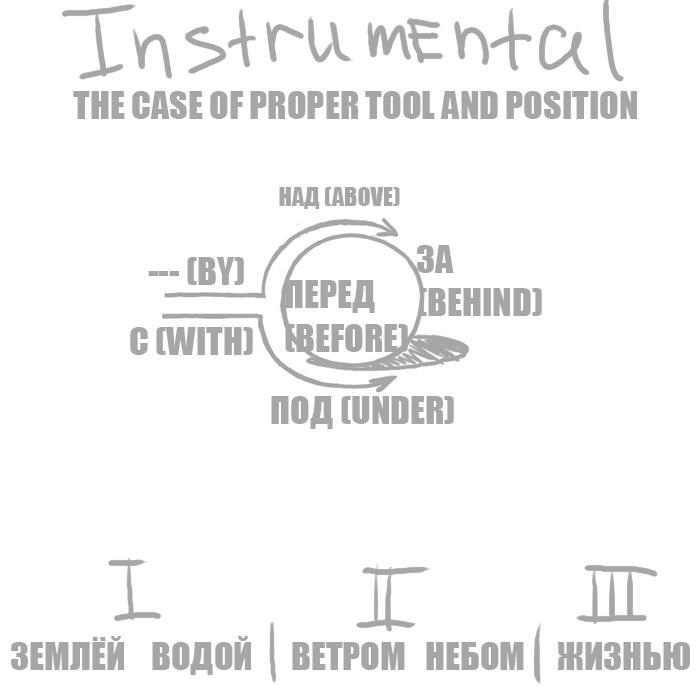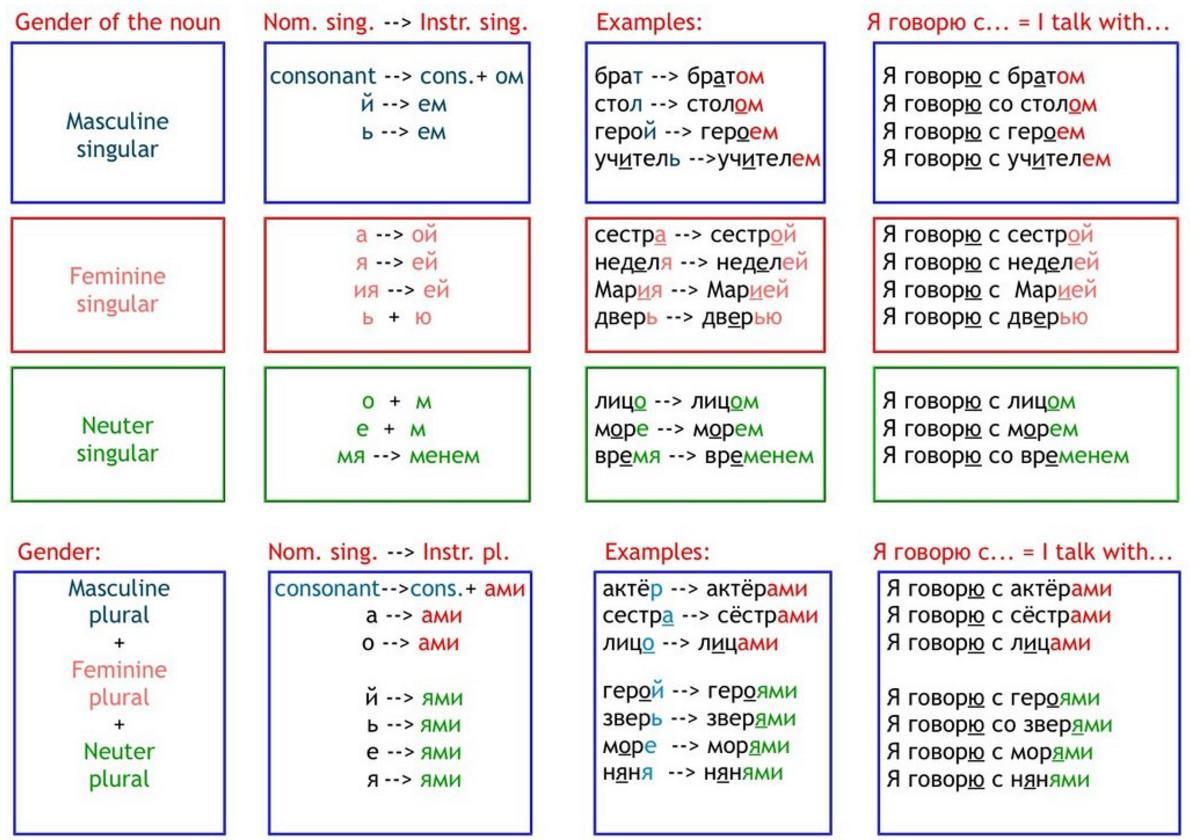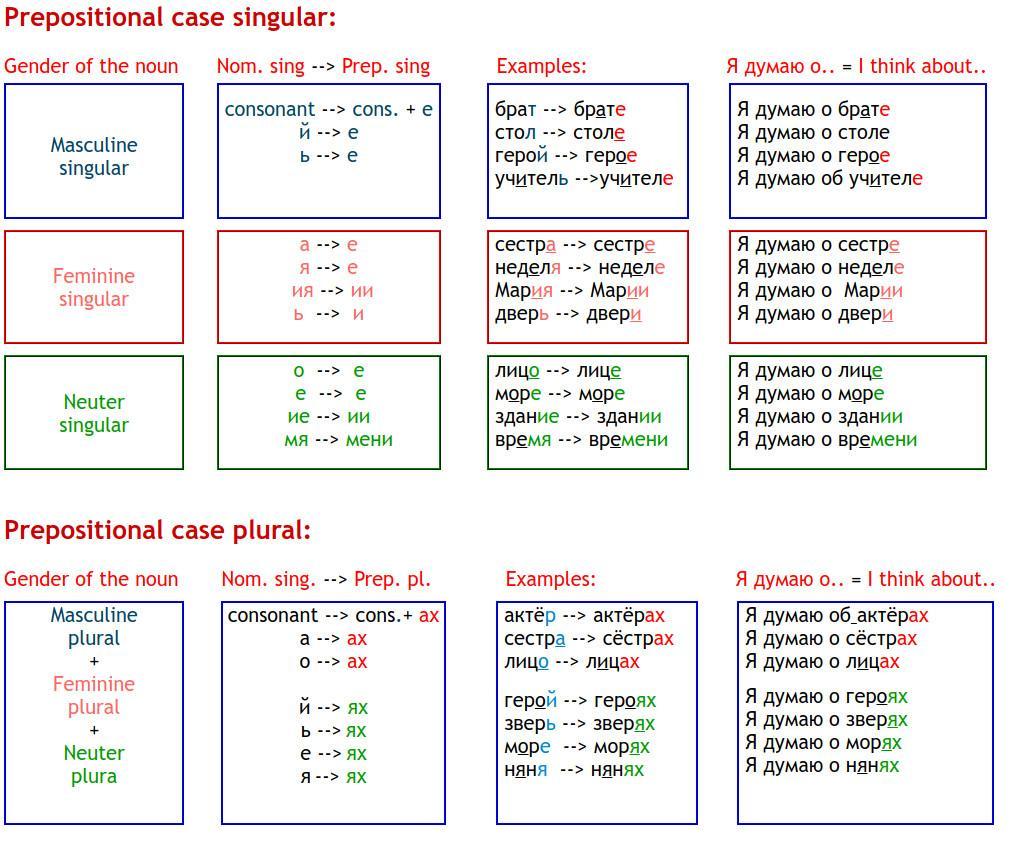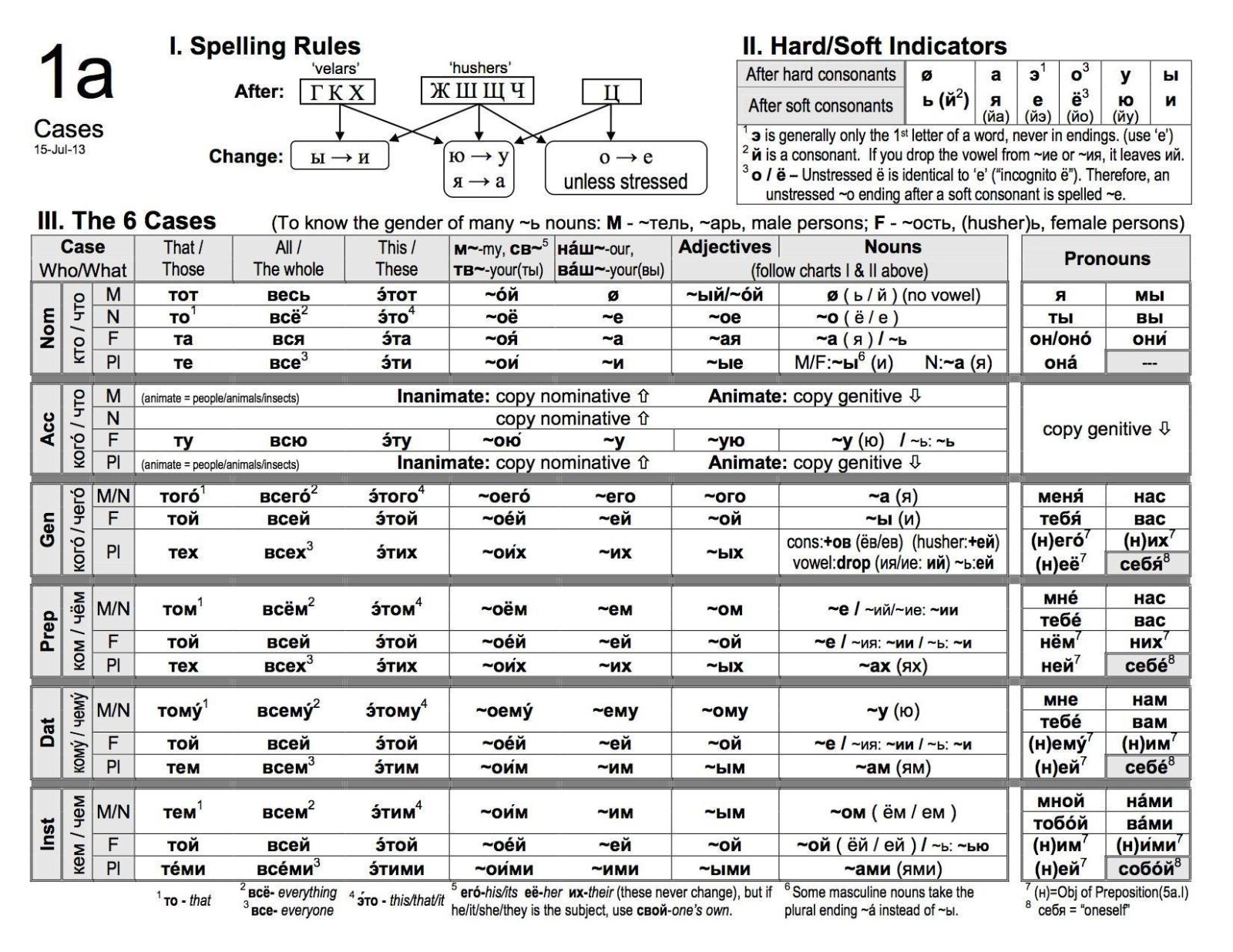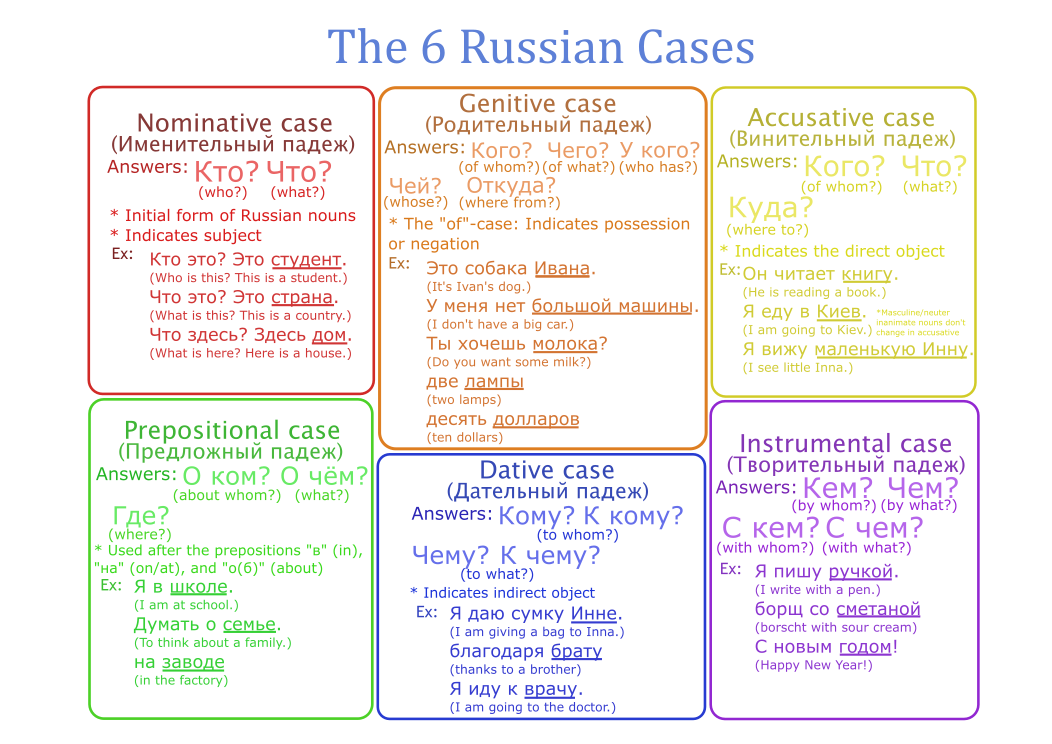How to learn Russian cases. The Best visual sheets, charts about Russian cases.
[adsense:300x250:6538780580]
What is the case?
In general, cases are situations where the word has appeared.
Here is the visual example.
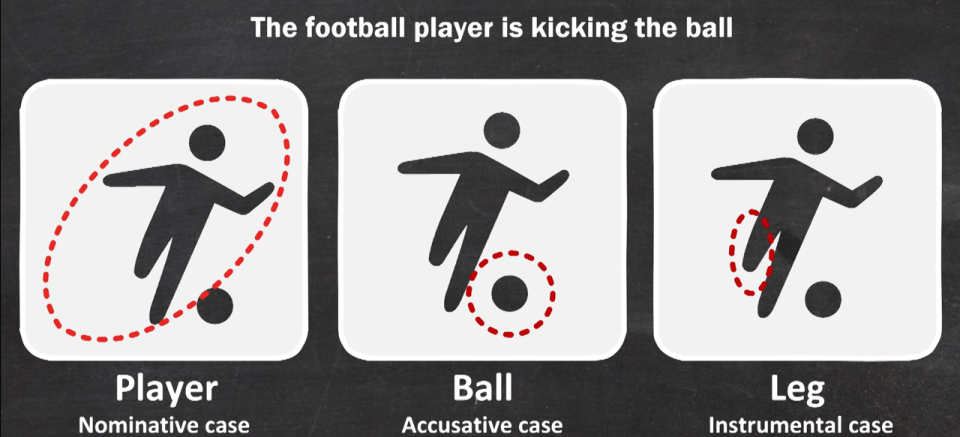
In this example, the football, or the soccer player, is kicking a ball. The player himself is playing the leading role here, and he is kicking the ball. The ball is kicked by the player that’s why it plays the role of the object here. And the ball is kicked with the leg, or in other words, the player used his leg to kick the ball. So, in this situation, there are three nouns: the player, the ball and the leg. That’s why the cases are needed - to identify who is who in this situation. Obviously, the player is the main here. The leg is his instrument, and he uses it to kick the ball. The ball is the object lying on the grass and waiting to be kicked. When the player kicks the ball, well, the ball will be flying and will be the main part of the sentence. But now the ball is only the object. I hope you have understood that. So, a word can play a leading role in the sentence and do something, or something may be done to it, with it or about it, on it, after it, inside it and so on. That is what cases are. They show this stuff. They show the role of the word.
Educational materials
1. The Case Book for Russian (Russian Edition)
This book is absolutely fantastic and a must for individuals wanting to master the Russian cases. I have only used this book for one month and it is already paying serious dividends. I love how it is organized and explains WHERE AND HOW to employ the cases.
- Each case is organized into large chapters [nominative, instrumental, accusative, dative, genitive, locative (prepositional)] making for easy finding and concentrated studying.
- The book clearly explains what circumstances to use each case in
- The book gives detailed case tables at the beginning of each chapter, including differences between hard and soft noun modification
- The book uses REAL sentences pulled from actual Russian sources, so it is in its most pure form.
- The book has detailed exercises at the end and a computer CD to check them with (native female speaker pronunciation included)
"The Case Book for Russian" has a very modern textbook layout. The authors use great layouts on the difficult subject matter of the use of each Russian case. I am very impressed by the layout (similar to adult education reader friendly beginning math or language books).
The translation sentences are very well selected and complex. There is plenty English so you can read the book.
Since the subject matter is a bit hard, one could say that it is not a fast reading book (maybe similar to second year Russian textbooks in topics), but I don't think the authors have any area to improve on. They have made a big smart effort.
The book is in very new condition in shrink wrap. It is paperback in 8.5 by 11 inch. The CD is in the back cover. It took a few weeks to arrive. I like educational methodologies: so I am impressed. The subject of using word case endings is not easy. I suppose the book is not in stores because this is a fairly difficult subject matter. I see no fault of the book layout or the authors efforts.
I have seen some tiny decent books on this topic, but this is the fuller treatment. A college textbook scatters such case information throughout the book. This book organizes the cases topic directly.
I have history, accounting, and law degrees at age 59, have a tourist interest in Russian, and appreciate very modern textbook layouts such as here with a CD:
- The Complete Idiot's Guide to Learning Russian, 2nd Edition
- Essential Russian Grammar (Dover Language Guides Essential Grammar)
- Oxford Russian Grammar and Verbs
4 parts of speech can have cases: nouns, adjectives, numerals and pronouns. But the main thing is, of course, cases of nouns. Because other parts of speech have the same case as the noun, so they depend on it. One more example – a deeper one. To make you understand the cases better. Let’s take the word TABLE.
The table can find itself in different situations and can play different roles in the sentence. Let’s take the word TABLE and look at what happens with it in different cases.
Nominative case
- У меня есть стол - I have a table.
Genitive case
- У меня нет стола - I have no table.
Dative case
- Я подарю каждому из вас по столу - I will present a table to each one of you.
Accusative case
- Я люблю этот стол - I like this table.
Instrumental case
- Я доволен своим столом - I am happy with my table.
Prepositional case
- Я думаю о своём новом столе - I am thinking about my new table.
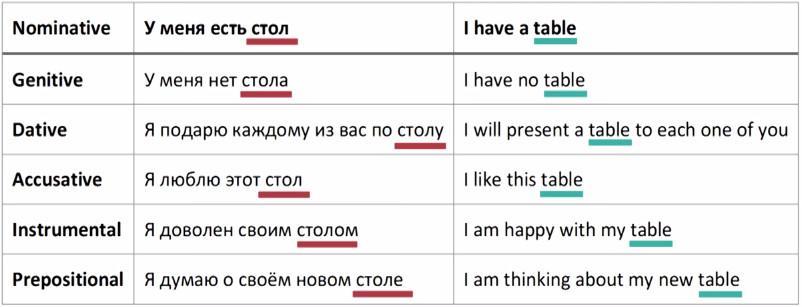
Now, look at English examples. We declined the word table in different cases. And actually, we see no real significant and visible difference. The word "table" stays the same in every sentence. That’s why cases in English are only some theoretical stuff needed for specialists only, maybe. But those who learn English as a foreign language do not learn cases at all. Technically, in English, we use prepositions and other nouns to identify what role the table plays in the sentence. And I like this English approach because it is simple. But in Russian, the situation changes dramatically. The word TABLE – СТОЛ changed its ending 4 times, 2 times it didn’t. That’s why we need to learn cases in Russian. Because in Russian, we use cases everywhere and a lot. I mean, in every sentence. And in different cases, the words have different endings.
4 parts of speech:
nouns, pronouns, adjectives and numerals change their ending.
And spoken and written differently. And it happens in every sentence!
So, in simple words, case shows the role of the word in the sentence.
Along with cases, a very important moment is declension. Or in Russian, it is called "склонение". Declension is when you change the form, gender or the case of the word. And in Russian language, it is done via changing the ending of the word. So, declension is the mechanism of changing the word from its original form by changing the case, gender or the form. And, again, we decline words by changing their endings.
We simply change the last letter of the word or last few letters. According to rules.
There are 6 cases in Russian:
- nominative,
- genitive,
- dative,
- accusative,
- instrumental,
- prepositional.
And 4 parts of speech can have cases:
- nouns,
- adjectives,
- numerals,
- pronouns.
So, to learn cases, it means to learn to change endings for 4 parts of speech in six cases.
- Moreover, in singular and plural forms, there are different endings for the same cases.
- In addition, in masculine, feminine and neuter genders, words have different endings.
- Plus, there are irregulars in Russian.
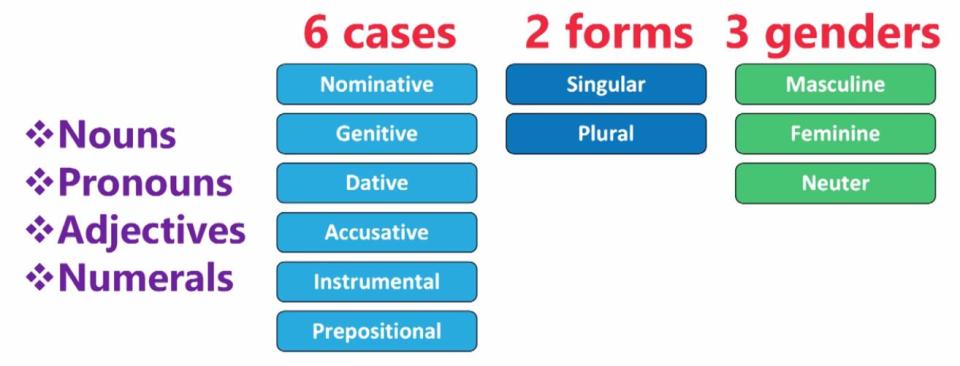
So, there is a pretty large amount of stuff.
That’s why cases are called the hardest part of Russian grammar.
And when you learn them – the most of Russian grammar will be behind.
How to learn Russian cases
The key to understanding cases and learning to decline words lies in the first unit of Russian grammar – Russian cases of nouns. To learn cases in general, you must, first, master Russian nouns – the main part of the speech. Because, first of all, the case of other parts of speech depends on the noun. They have the same case. Second, the mechanism of declension of other parts of speech is the same as in nouns. But more simple! So, in the nouns unit, you will learn how to know the case and how to change endings.
And later, you will be applying your knowledge to other parts of speech. And the difficulty level will be decreasing.
So, the noun is the main and hardest part of Russian grammar and the thing is that you need to learn it first. And it means to learn the basic information about nouns, to learn the forms of nouns and to be able to change them, to learn genders of nouns and to be able to identify the gender without any stumbling. And only then you learn cases of nouns. So, to learn the cases you need to learn forms and genders first.
Recommend:
Genders
The situation with Russian genders is pretty different from English. Yes, we have the same 3 genders. Neuter, masculine, and feminine.
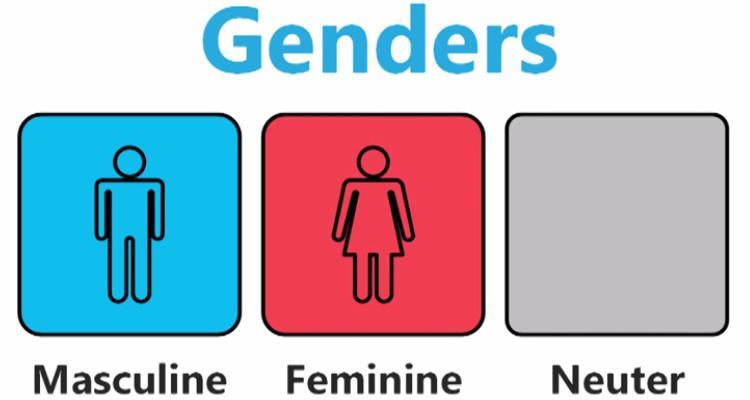
But many English neuter words in Russian have masculine or feminine gender.
Like, in Russian, a computer is "he" Internet is also "he". YouTube? Also "he". While your keyboard or mouse is "she". Because in Russian the gender of nouns depends on their ending. And according to rules, you need to learn to identify the gender of nouns. And the gender of other parts of speech depends on nouns. So, again, nouns are essential, and when you learn to identify the gender of nouns, you will know the gender of other parts of speech.
Forms
Well, Russian and English are very close here. The same singular and plural forms. And the same mechanism of changing the ending.

In English, to get the plural form you add -s or -es to the nouns usually. In Russian, you add also an ending. So, there is the same mechanism.
Learning cases
The thing is that cases are not some isolated thing. And they are very interconnected with forms and genders. And cases are learned through the mechanism of declension. Before, I told you about declension. It is changing a form, gender or a case of the word. And it is done via changing the ending. Maybe you have seen that there are 1, 2, 3 declensions in Russian grammar. If not – no biggie. Generally, these are just rules that combine the gender and the case altogether. You can learn Russian grammar through this mechanism. Or there is the way that does not involve this mechanism. It depends on the textbook you are learning with. Here is what I mean. Here is the rule for the genitive case for nouns. And the mechanism is the following.
We take a noun. In the nominative case. It is the default case, and all nouns in the dictionary are in the nominative case. And we change the ending according to gender and the form.
The word ДОМ – HOUSE.
We look at the word and according to its last letter, we see that it has a masculine gender. Because it ends in a consonant. So, to get a singular genitive form, according to the rule we add –А.
And get ДОМА.
ДОМ - ДОМА.
If we want genitive plural, we add –ОВ and get ДОМОВ.
ДОМ - ДОМОВ.
So, we say in the genitive case: I have no house – У меня нет дома
I have no houses – У меня нет домов.
So, that is the mechanism.
We identify what case we want a noun (or other parts of speech) to be.
Then, according to rule, we detect it’s gender.
Decide what form it should be and BANG – change the noun into the case.
Nailed it! It is done with the help of rules and practice. Especially practice.
Have you seen the rule I have shown you?
Well, there are 5 such big rules for all cases except the nominative. And several minor rules. And that’s only for nouns unit!
Do you really think you can learn them all?
I do not stop repeating that language is a skill. And you can study all that by simply understanding the theory and practicing a lot.
OK. Now one very important moment.
How can I know that I need prepositional case, or instrumental, or accusative?
Or some other. Well, you can’t at your current level. And you should not bother yourself with this question. You will need your endings changing skill in the future.
Bonus. The Best visual sheets about Russian cases.
Nominative. The boss case.
This is the basic form of a noun, you would look for in a dictionary.
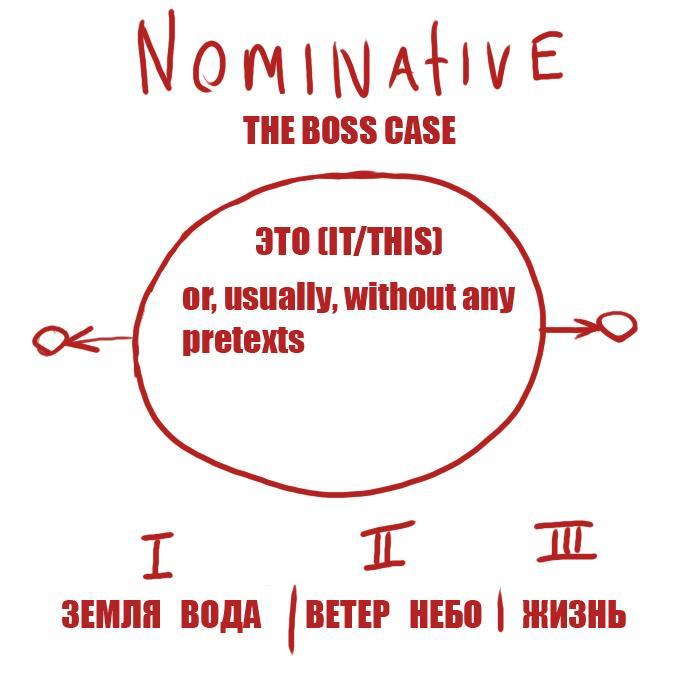
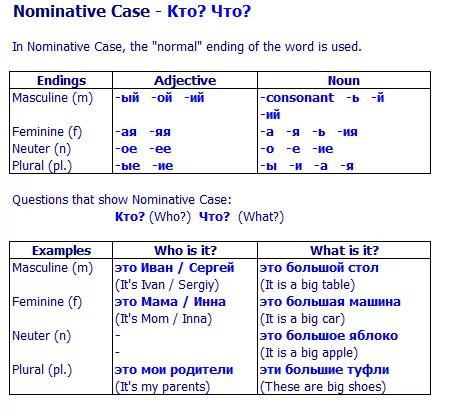
Genitive. The case of complex relations.
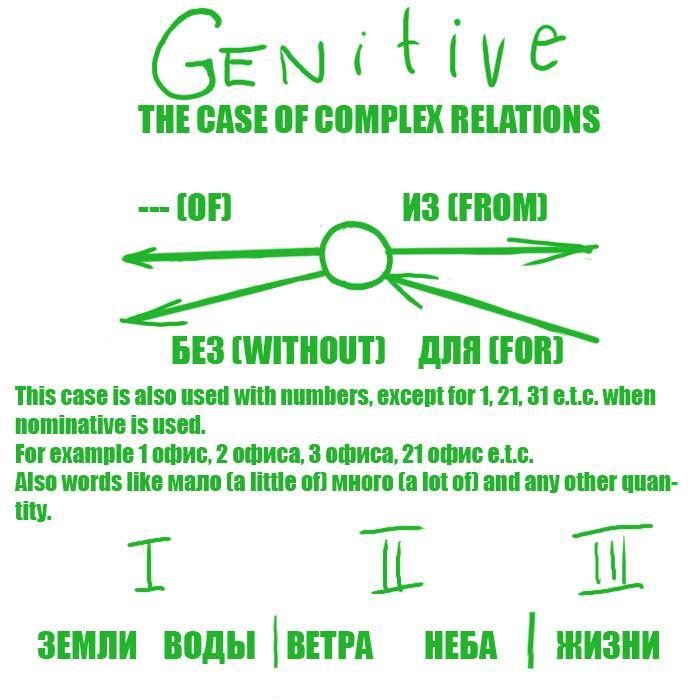
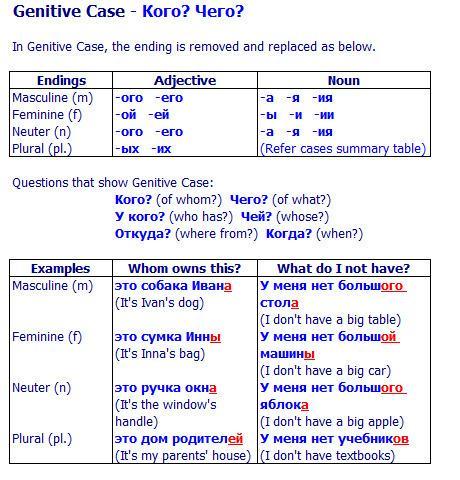
Dative. The movement case.
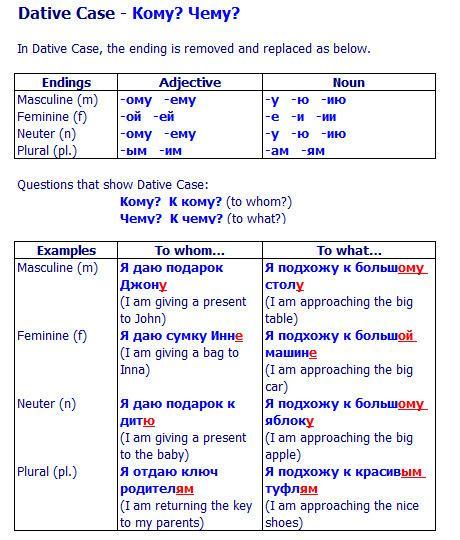
Accusative. The case of being pwned.
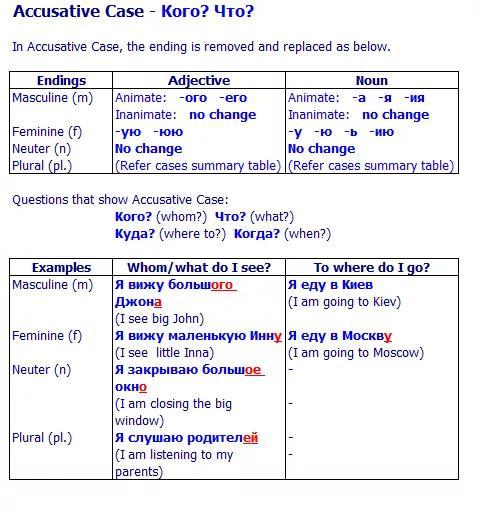
Instrumental. The case of proper tool and position.
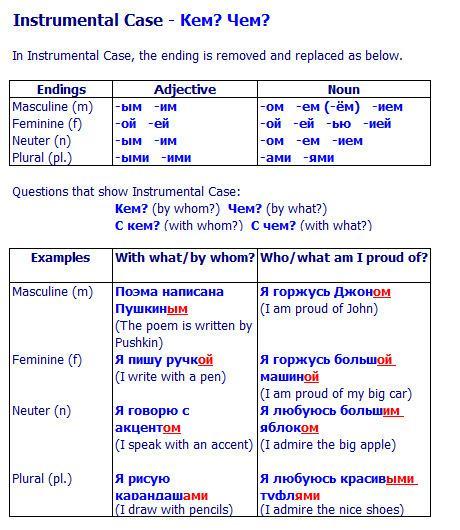
Prepositional. The case of lying and dreaming.
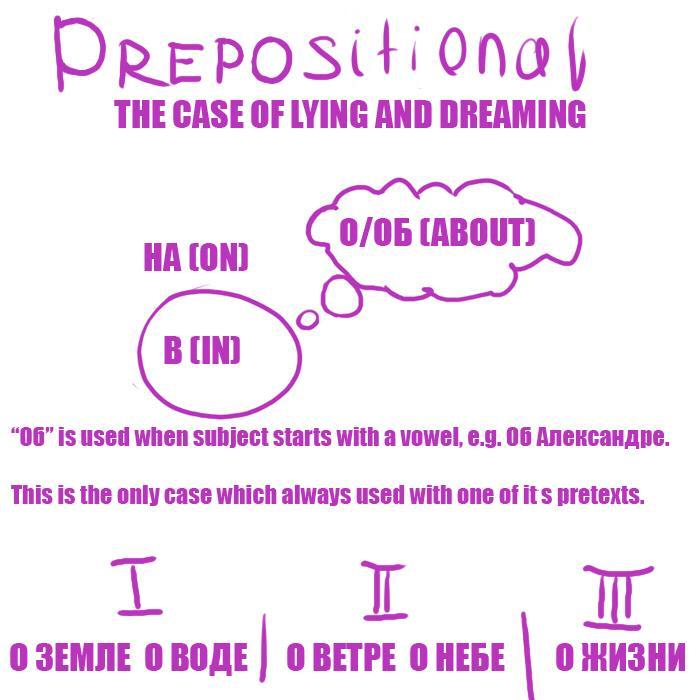
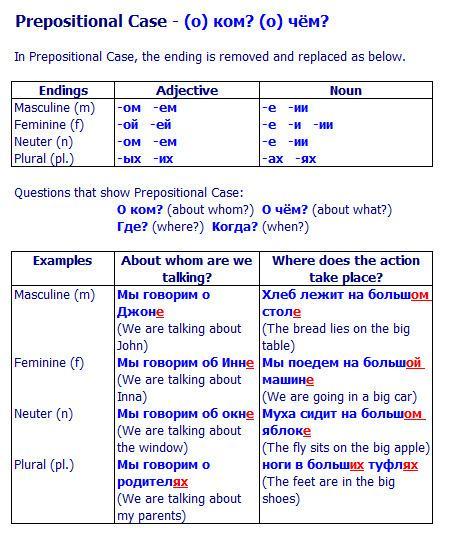
The 6 Russian Cases Endings
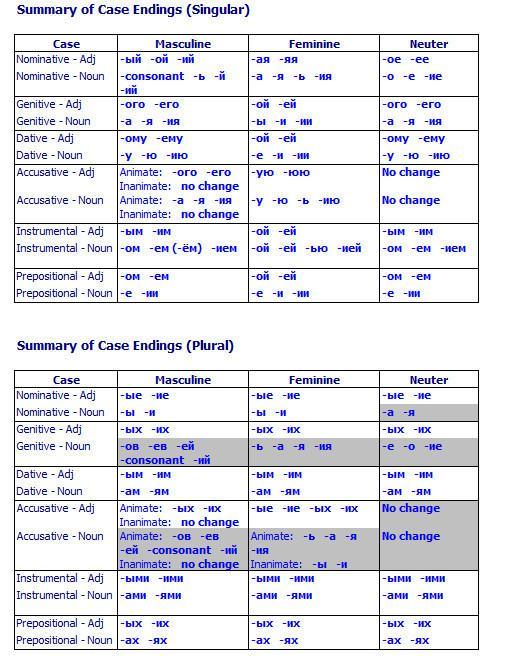
For now, just learn the theory. And I mean to understand it. Not memorizing. Practice with exercises. Here, I mean that exercises should be easy for you. It means you need more practice than most textbooks offer. That’s why I usually recommend having several textbooks. To have more exercises to practice.
Now, one more thing. Imagine that you can’t ride a bicycle, and decided to teach yourself. You get a textbook about how to ride it. So, it says,
When riding, to turn the bicycle, you need to keep its stability by following the empirical rule: Sine of the angle of tilting is inversely as the square of angular velocity of rotation of a wheel divided by the weight of the cyclist.
Well, this info is very helpful. Now, you know how to turn the bicycle. Wait, but when you go outside, you see your neighbor’s son is successfully riding his bicycle without even knowing what sine and angular velocity actually mean. The same is with cases and grammar. There are so many rules there. What you need to do is to go through their learning, understand them, practice a lot, develop proper patterns and habits. Then, to forget all that stuff but speak and write properly according to properly learned and formed habits and patterns.





